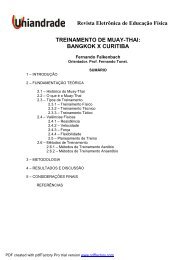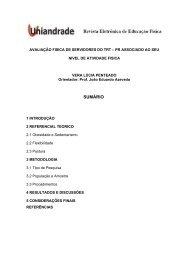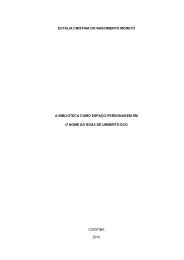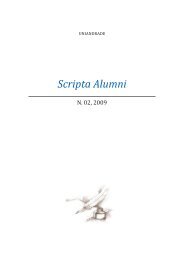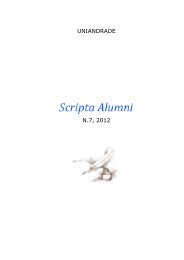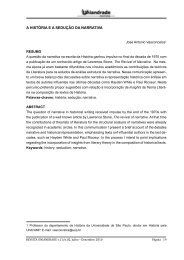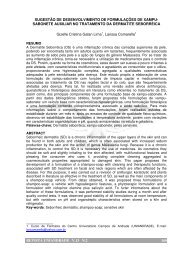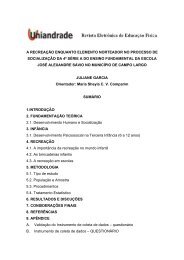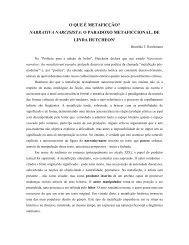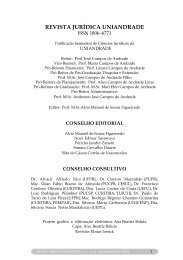Scripta 9_2_link_final.pdf - Uniandrade
Scripta 9_2_link_final.pdf - Uniandrade
Scripta 9_2_link_final.pdf - Uniandrade
Create successful ePaper yourself
Turn your PDF publications into a flip-book with our unique Google optimized e-Paper software.
Whitehall Palace and, probably because of its great success at the time,<br />
opens the First Folio as the first of the Shakespearean comedies. Published<br />
after the writer’s death, in 1623, due to the efforts of the actors John<br />
Heminges and Henry Condell, the First Folio is the first collection of<br />
Shakespeare’s dramatic work. Of a total of thirty-six texts in the Folio, eighteen<br />
had not been published before.<br />
The plot of The Tempest consists of a story of vengeance, love and<br />
conspiracies that accompany the fate of Prospero, the Duke of Milan.<br />
Dedicating a great deal of his time to books, especially those of magic, he<br />
withdraws from the state affairs and has his dukedom usurped by his own<br />
brother, Antonio, who, in his search for power, begins to persecute Prospero,<br />
aiming at destroying him. With the help of Gonzalo, a counselor to the king<br />
of Naples, Prospero flees to a Mediterranean island with his daughter<br />
Miranda. Gonzalo supplies the vessel with provisions, clothes and books.<br />
On the enchanted island, at Prospero’s service, are the slave Caliban, a<br />
creature half-human, half-monster, and Ariel, a servile spirit, who can be<br />
metamorphosed into water, air and fire. Prospero’s main objective is to<br />
take revenge on his traitors. Twelve years later, Alonso, king of Naples, and<br />
his retinue travel for the wedding of Alonso’s daughter Claribel. On their<br />
voyage back from Tunis, a great tempest causes Alonso’s vessel to go adrift,<br />
forcing everybody on board to abandon the boat. The shipwrecked survive<br />
and find shelter on Prospero’s island. They do not know, however, that the<br />
storm, caused by magic with Ariel’s aid, and the voyagers’ dispersal were<br />
part of Prospero’s vengeance plan. Even so, instead of subjugating his<br />
enemies, Prospero forgives them, thereby regaining his dukedom.<br />
Peter Greenaway’s film, Prospero’s Books, is viewed by many critics<br />
as an eccentric or extravagant adaptation of Shakespeare’s The Tempest.<br />
Although Greenaway’s aesthetic artifact approaches Shakespeare’s classic<br />
text with due respect, the images that appear on the screen do not have the<br />
function of reproducing faithfully the succession of events in the dramatic<br />
text. In other words, the filmmaker visually transforms certain passages of<br />
the source text, superimposing images to actor John Gielgud’s reading of<br />
the play’s original version. Thus, the five acts of Shakespeare’s text make<br />
themselves literally audible.<br />
While Greenaway’s earlier works consisted in a reflection on an<br />
artistic form, Prospero’s Books is the first film where he brings someone else’s<br />
argument to the cinema screen. The very choice of the film’s title points at<br />
the procedure adopted by Greenaway in his rereading of the Shakespearean<br />
<strong>Scripta</strong> <strong>Uniandrade</strong>, v. 9, n. 2, jul.-dez. 2011 99



